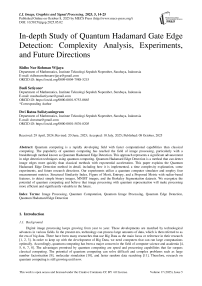In-depth Study of Quantum Hadamard Gate Edge Detection: Complexity Analysis, Experiments, and Future Directions
Автор: Ridho Nur Rohman Wijaya, Budi Setiyono, Dwi Ratna Sulistyaningrum
Журнал: International Journal of Image, Graphics and Signal Processing @ijigsp
Статья в выпуске: 5 vol.17, 2025 года.
Бесплатный доступ
Quantum computing is a rapidly developing field with faster computational capabilities than classical computing. The popularity of quantum computing has reached the field of image processing, particularly with a breakthrough method known as Quantum Hadamard Edge Detection. This approach represents a significant advancement in edge detection techniques using quantum computing. Quantum Hadamard Edge Detection is a method that can detect image edges more quickly than classical methods with exponential acceleration. This paper explains the Quantum Hadamard Edge Detection method in detail, including how it is implemented, a time complexity explanation, some experiments, and future research directions. Our experiments utilize a quantum computer simulator and employ four measurement metrics: Structural Similarity Index, Figure of Merit, Entropy, and a Proposed Metric with radius-based features, to detect simple binary images, MNIST images, and the Berkeley Segmentation datasets. We recognize the potential of quantum computing and believe that image processing with quantum representation will make processing more efficient and significantly valuable in the future.
Image Processing, Quantum Computation, Quantum Image Processing, Quantum Edge Detection, Quantum Hadamard Edge Detection
Короткий адрес: https://sciup.org/15019977
IDR: 15019977 | DOI: 10.5815/ijigsp.2025.05.02


